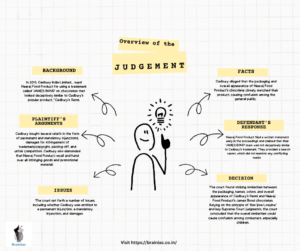Introduction
The case of Mondelez India Foods Pvt. Ltd. (formerly Cadbury India Limited) vs. Neeraj Food Product, also known as the Cadbury’s Gems vs. James Bond case, was an important decision in the field of intellectual property rights. In this case, the Delhi High Court decided based on the principle of ‘Res Ipsa Loquitur,’ which means ‘the thing talks for itself.’ The court found many links between the goods/products in question of the Plaintiff (Cadbury) and the Defendant (Neeraj Food Product) and concluded that the presumption of negligence can be seen by looking at the facts of the case.
Background and Facts of the Case
In 2015, Cadbury India Limited, which is now known as Mondelez India Foods Pvt. Ltd., sued Neeraj Food Product for using a trademark called ‘JAMES BOND’ on chocolates that looked deceptively similar to Cadbury’s popular product, “Cadbury’s Gems.” Cadbury alleged that the packaging and overall appearance of Neeraj Food Product’s chocolate closely matched their product, causing confusion among the general public. Cadbury also pointed out that ‘JAMES BOND’ was based on their imaginary character ‘GEMS BOND,’ who was used in their ads and comics in the late 1980s and early 1990s.
Plaintiff’s Arguments
Cadbury sought several reliefs in the form of permanent and mandatory injunctions, damages for infringement of trademark/copyright, passing-off, and unfair competition. They requested the court to restrain Neeraj Food Product from using the trademark ‘JAMES BOND’ or any other visually or phonetically similar marks. Cadbury also demanded that Neeraj Food Product recall and hand over all infringing goods and promotional material. Additionally, Cadbury wanted to inspect the accounts of Neeraj Food Product to determine the extent of damages.other visually or phonetically similar marks. Cadbury also demanded that Neeraj Food Product recall and hand over all infringing goods and promotional material. Additionally, Cadbury wanted to inspect the accounts of Neeraj Food Product to determine the extent of damages.
Plaintiff’s Trademark Registrations and Copyright
Cadbury presented various trademark registrations related to their brand name ‘GEMS,’ all filed under Class 30. These registrations included ‘CADBURY’S GEMS (DEVICE),’ ‘GEMS (DEVICE),’ ‘CADBURY’S MILK CHOCOLATE GEMS (WORD),’ and ‘CADBURY’s GEMS (DEVICE).’ Furthermore, Cadbury owned copyrights for artistic illustrations of the character ‘GEMS BOND,’ used in their promotional advertisements.
Issues Framed by the Court
In the case, the court set forth a number of issues, including whether Cadbury was entitled to a permanent injunction, a mandatory injunction, and damages. The court also considered who owned the trademarks and copyrights for “GEMS BOND” and whether Neeraj Food Product’s actions amounted to passing off and trademark infringement.
Defendant’s Arguments
Neeraj Food Product filed a written statement early in the proceedings and claimed that their ‘JAMES BOND’ mark was not deceptively similar to Cadbury’s trademark. They provided a search report, which did not mention any conflicting marks. However, Neeraj Food Product’s evidence was limited, and they failed to provide substantial defence against Cadbury’s claims.
Judgements Referred
The court referred to the case of Corn Products Refining Co. v. Shangrila Food Products Ltd., where the Supreme Court introduced the concept of viewing the issue of deceptive similarity through the eyes of an ordinary person with imperfect recollection. In applying this principle to the current case, the Delhi High Court considered how the packaging and appearance of Cadbury’s Gems and Neeraj Food Product’s James Bond chocolates would be perceived by an average consumer, particularly children. Because both products were aimed at children, the court determined that the similarities were striking enough to cause consumer confusion.
Secondly, in the case of ITC Ltd. v. Britannia Industries Ltd., the issue revolved around deception and confusion caused by two products having identical packaging. The Court in this case emphasized the importance of considering the overall similarities in packaging and appearance, especially when the targeted consumers are not well-versed in discerning minute differences. The Court, relying on the ITC judgment, highlighted that even the likelihood of confusion among children was critical in this case, as they might not be able to discern the differences between the two products easily.
Judgment and Analysis
The court found striking similarities between the packaging, names, colors, and overall appearance of Cadbury’s Gems and Neeraj Food Product’s James Bond chocolates. Relying on the principle of ‘Res Ipsa Loquitur’ and key Supreme Court judgments, the court concluded that the overall similarities could cause confusion among consumers, especially children.
The court ruled in favour of Cadbury on all issues and granted permanent and mandatory injunctions, damages amounting to Rs. 10 lakhs while emphasizing on the importance of protecting intellectual property rights and ensuring fair competition in the market.
Conclusion
A significant precedent in Indian trademark law is set by the current case. The ruling emphasises the necessity for businesses to conduct extensive searches before adopting new marks in order to avoid legal disputes, strengthening brand owners’ rights, and serving as a deterrent against potential infringers. The situation serves as an example of how Res Ipsa Loquitur works when the weight of the evidence points to negligence or infringement. This case serves as a reminder of the significance of respecting and protecting intellectual property rights as businesses continue to innovate and compete in the market.



